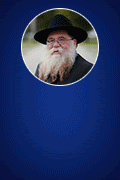Rabbi Menachem Mendel Shemtov, fondly referred to by Anash as Reb Mendel, was born in Poltova on the 28th of Sivan in 1933 to Horav Hachossid Reb Benzion and his wife Golda. For most of Mendel’s childhood, his father was exiled to Siberia for the self-sacrifice of opening chadorim and spreading Yiddishkeit to children in Russia.
Our Heroes: R. Menachem Mendel Shemtov (1933-2006)
Rabbi Menachem Mendel Shemtov, fondly referred to by Anash as Reb Mendel, was born in Poltova on the 28th of Sivan in 1933 to Horav Hachossid Reb Benzion and his wife Golda. For most of Mendel’s childhood, his father was exiled to Siberia for the self-sacrifice of opening chadorim and spreading Yiddishkeit to children in Russia.
Siberia and all it implied was something Reb Mendel grew up with. To start with, his parents were married in Siberia. Most significantly, his father was the first of ten Chassidim of the Previous Rebbe to give an unbreakable oath – a tekias kaf, that on pain of life or death, Yiddishkeit would continue to flourish in Russia.
Reb Mendel grew up in a time of rampant hunger and as the oldest child, at nine-years of age, he wanted to help his family. He brought linen to the tailor and proposed that he make bags to sell. The tailor liked the idea and paid Mendel, who bought bread for his family. In later years, Reb Mendel became a manufacturer of plastic bags.
Sacrificing For Chinuch
When Reb Mendel was growing up, Reb Benzion thought it important enough to spend desperately needed money on a bicycle for his son, an expensive luxury, to keep him from playing with non-Jewish neighborhood friends. When he was six-years old, he began traveling to a yeshiva far from his home in Kharkow, because the nearby school was not based on pure Torah ethics.
The cheder in Russia
His teacher was Reb Eliyohu Chaim Roitblat and they met in a basement where Reb Mendel studied with his friend, Reb Mordechai Kazliner. When he became Bar-Mitzva, his father was in Siberia and to mark this special occasion, his mother sewed him a new suit using a set of slipcovers. The Bar Mitzva bochur did not have Tefillin. On the day of his Bar Mitzva, he walked first to one house, where he received a shel yad Tefillin, and after walking an additional distance he successfully found a shel rosh Tefillin. This is how he put on Tefillin for the first time in his life.
One Friday his father was at the mikva when the KGB came to the house. His mother sent Mendel to alert his father, who fled immediately. The family did not see him for another month. In 1949, when Mendel was sixteen years old, the Shemtov family left Russia for France. He began his studies in Brunoy, but had a strong yearning to see the Rebbe. On the 20th of Cheshvan 5712 (1951), Mendel arrived in the United States. That evening a Farbrengen took place among the older Chassidim. On his way home, the Rebbe asked “Does anyone know if Mendel Shemtov arrived this evening?” The bochurim found Mendel sleeping, woke him and told him that the Rebbe asked that he go to the Farbrengen.
Arrival in the United States
In the summer of 1952, Reb Mendel went on Merkos shlichus to Minnesota with his friend Rabbi Yehuda Krinsky, later a member of the Rebbe’s secretariat. They visited different cities in search of Jews. Rabbi Moshe Feller, currently the Rebbe’s shliach in Minnesota, lived in Minnesota and studied at Yeshiva Torah Vodaas. When he saw two bochurim dressed in Chassidic garb in the blazing summer heat, he was astounded. He began following them, and they were mkarev him to Chabad chassidus.
As a bochur in 770, Reb Mendel would repeat a Maamor orally for the congregants in a Flatbush shul. One of the congregants, a son-in-law of the Stock family, began observing the bochur, and introduced him to his future wife, Miss Sarah Stock.
The wedding took place in 1956 and the Rebbe was Msader Kidushin – officiating at the wedding. Many Chassidim rejoiced as if their close relative was getting married.
One of the sheva Brochos took place at Camp Gan Yisroel on the occasion of the Rebbe’s first visit to the camp. The Rebbe conducted the benching and in honor of the Chosson and Kallah added “shehasimcha b’mono”, as is customary.
Reb Mendel entered the business world after his marriage. At that time, couples did not leave in shlichus as routinely as is common today. Reb Mendel was very active in communal affairs, and assumed numerous responsibilities publicly and behind the scenes.
Rabbi Avrohom Shemtov described his brother’s home. “The house was a center for many activities and was as active as a hot pot. His home was designated not only for Farbrengens but for bochurim to come and discuss any matter. For every mivtza that bochurim involved themselves, they knew that they would find support, assistance and warmth at Reb Mendel’s house”.
Reb Mendel once recalled his early years in Crown Heights. “In 1955 there were very few Lubavitch yungeleit who were in business and owned a car as I did. Rabbi Hodokov called me and requested that I visit a patient in the hospital. From then on, he would call on me for different things on behalf of Machne Israel, one of the Rebbe’s mosdos.”
Although he had a large and successful business, Reb Mendel worked tirelessly in serving the institutions of the shechuna in order to give the Rebbe a nachas ruach. Every day he would speak with Rabbi Hodokov, the Rebbe’s personal secretary, who would relay the Rebbe’s directives.
Shechuna and communal affairs
Over the course of the years, Reb Mendel was entrusted with many different projects and tasks. Heading these were shlichusen for the Rebbe to the Far East. Reb Mendel would travel there for business and would receive specific instructions to carry out while overseas. Describing them would be an article in itself. His most prominent position for many years, was heading the Crown Heights Community Council. In that capacity, his main struggle was to ensure that Crown Heights retained its Jewish presence.
Reb Mendel was also involved in creating and building Yeshiva Oholei Torah. He invested a lot of energy and thought into the yeshiva.
The Rebbe’s autograph
When the Rebbe published Likutei Torah, the Alter Rebbe’s discourses, he asked that nine people be included in the publication of the sefer, and do so by helping sponsor the costs. Rabbi Mendel was one of the nine people who contributed a large sum of money. Each one of them was called into the Rebbe’s room and handed a Likutei Torah containing the Rebbe’s signature on the first page.
In 1970, the Rebbe initiated the campaign to abolish the “Law of Return”. This law had recently been passed in Israel and did not recognize Halacha in converting non-Jews to Judaism. The Rebbe spoke about this issue on every possible occasion for many years. On Lag B’omer, directly after the Bar Mitzva celebration of his oldest son, Reb Mendel arranged an urgent meeting with a group of Chassidim to develop practical resolutions in the struggle against this law.
Creating the Algemeiner Newspaper
In the beginning of the 1970’s, the Yiddish newspaper “Tog Morgen Journal”, a unique publication containing Torah and Chassidus, closed its doors. The end of the newspaper and the lack of any reaction to its closure caused the Rebbe great aggravation. Reb Mendel met with two yungeleit and that same day decided to open a Yiddish newspaper, “The Algemeiner Journal”, with Reb Gershon Jacobson as editor. Reb Avrohom Shemtov recalled, “He (Reb Mendel) carried the responsibility of the expenses. He did this behind the scenes, received no public acknowledgement and that was how he wanted it. As with everything that he did, his main goal was to see that things got done.”
Crown Heights Mosdos
His devotion to the mosdos of Crown Heights knew no limits. At the time, Bais Rivka was located in a changing neighborhood and urgently needed to relocate to Crown Heights. The building that had housed the Yeshiva of Crown Heights was ideal. Reb Mendel discussed the matter with a few Chassidim during Pesach. After a few days the building was purchased for Bais Rivka.
When Jewish ownership in the shechuna started to decline, and people began moving away, the Rebbe gave Crown Heights the Halachic classification of “territories”, which accordingly could not be abandoned. This marked the beginning of a new campaign.
Reb Mendel was the ‘hands and the feet’ of the Rebbe’s campaign. In addition to being the first, as a newly married man, to buy a house, he was the Rebbe’s agent in all of the activities in this huge and important effort.
This was reflected during the elections. All of the Rebbe’s mosdos, Merkos, Machne Israel, and the Library, received very clear directives from Rabbi Hodokov to vote for Rabbi Shemtov and for the block that he endorsed. Everything that Reb Mendel did in his function as a council member was guided by directives from Rabbi Hodokov. Demonstrations regarding the future of the shechuna, in which the gaon Rabbi Moshe Feinstein personally participated, were organized by Reb Mendel.
Every day brought the grim news of another shul that had closed down and was being sold. Between the shuls and the buildings, every part of the shechuna was swiftly being conquered. It was a war of a minority against a majority. The struggle that the Rebbe conducted was very sensitive. He did not want this to be considered a Chabad struggle as much as a Jewish one; a Jewish neighborhood was being deserted. As the point man in this struggle, Reb Mendel was the lightning rod for comments and criticism,
Farband & Uforatzto Hall
An additional struggle took place over the “Farband”, later “Uforatzto”, and today the Kollel. Reb Mendel invested a lot of effort that this building, originally owned by Yiddishisten and centrally located on Kingston Avenue, should remain in Jewish hands. He first purchased it himself and then transferred ownership to the Lubavitch Youth Organization.
The same thing took place with the Young Israel shul at 935 Eastern Parkway. Until this point the community council did not purchase houses that were being sold. It only offered support and represented Crown Heights residents to government entities. Reb Mendel began the council practice of buying houses and mosdos that were being sold or deserted. This resulted in the purchase of the Young Israel.
Chanuka Gelt
In 1977, there was an attempt to draw wider boundaries for Crown Heights which would be greatly damaging to the Jewish community, who would be less significant and be lost within the much larger population. Acting upon the Rebbe’s directives, the community council took a non-negotiable stand against this plan. The community council received notice that their opposition was successful, and the Rebbe notified Rabbi Hodokov that he would be distributing Chanuka gelt to all of Anash. When Reb Mendel received his dollar, the Rebbe told him, “There should be a hemshech”- a continuation of his efforts and activities.
The Rebbe’s directives relating to the shechuna and the activities of the council reflected a dual perspective. On the one hand, the Rebbe was very particular that at all times the council should function as an independent institution and not be classified a Lubavitch mosad. On different occasions the Rebbe expressed his opinion merely as a “toshav hashechuna”- a member of the neighborhood. However, the person that Rebbe considered trustworthy and relied on to get things done was Reb Mendel, a Lubavitch chossid.
In later years, when Reb Mendel was no longer active in the Community Council, he participated in the founding and development of numerous mosdos; Hechal Menachem in Jerusalem, the yeshivas in Detroit and Arizona, the Tzierei Hashluchim Yeshiva in Crown Heights, the Shluchim office, Shluchim childrens networking school and more.
In early Nissan 5766 (2006), Reb Mendel came home from work and felt unwell. A short while later, he lost conscious and was taken to the hospital. In the evening of the thirteenth of Nissan, the Hilulo of the Tzemach Tzedek, for whom Reb Mendel was named, his Nshama returned to its creator at the age of 73. At his levaya the morning of Erev Pesach, the participants mourned the loss of a great person who dedicated himself to the wellbeing of the people in the shechuna, and did everything possible to maintain a safe Jewish neighborhood.
Reb Mendel left behind his wife, Mrs. Sarah Shemtov; his sons, Horav Yosef Yitzchok, shliach in Tucson, Arizona; Horav Kasriel of Crown Heights, the menahel of the cheder at the Ohel; Horav Levi, shliach in West Bloomfield, Michigan; his daughters, Mrs. Faige Duchman of Crown Heights; Mrs. Batya Treitel of Montreal.
Yehi Zichro Boruch! May Reb Mendel’s life as an askan, a communal leader who selflessly dedicated himself to saving the shechuna and its institutions, serve as the inspiration to concern ourselves with others in need, and to greet people with warmth and friendliness..
We should speedily witness “The ones who dwell in the dust will awaken and rejoice” with Reb Mendel amongst them.














Bartfield
Mendel bartfield ah is in the room as well.
correction
right next to reb mendel is bartfield .
Milhouse
1. The family left Russia in 1946, not 1949.
2. Reb Mendel was not named after the Tzemach Tzedek, but after his grandfather Reb Mendel Futerfas, who was named after the Tzemach Tzedek.
as
to #3
Thank you
The article is based originally on a Kfar Chabad article
Shin
I believe that he was born in 1931 not 1933
frauth724
comment on this post..